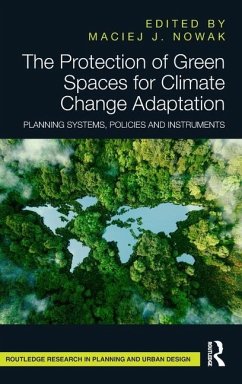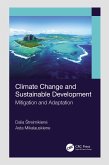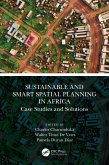The Protection of Green Spaces for Climate Change Adaptation
Planning Systems, Policies and Instruments
Herausgeber: Nowak, Maciej J
The Protection of Green Spaces for Climate Change Adaptation
Planning Systems, Policies and Instruments
Herausgeber: Nowak, Maciej J
- Gebundenes Buch
- Merkliste
- Auf die Merkliste
- Bewerten Bewerten
- Teilen
- Produkt teilen
- Produkterinnerung
- Produkterinnerung
The Protection of Green Spaces for Climate Change Adaptation identifies how spatial planning and climate change adaptation are linked by examining the protection of green spaces in cities across Europe, Africa, the Middle East, South America and Australia.
Andere Kunden interessierten sich auch für
![Cities and Climate Change Cities and Climate Change]() Harriet BulkeleyCities and Climate Change262,99 €
Harriet BulkeleyCities and Climate Change262,99 €![Climate Change and Social Ecology Climate Change and Social Ecology]() Stephen M WheelerClimate Change and Social Ecology197,99 €
Stephen M WheelerClimate Change and Social Ecology197,99 €![The Singapore Water Story The Singapore Water Story]() Cecilia TortajadaThe Singapore Water Story198,99 €
Cecilia TortajadaThe Singapore Water Story198,99 €![Green Productivity and Cleaner Production Green Productivity and Cleaner Production]() Guttila Yugantha JayasingheGreen Productivity and Cleaner Production126,99 €
Guttila Yugantha JayasingheGreen Productivity and Cleaner Production126,99 €![Community Vision and Leadership in Practice Community Vision and Leadership in Practice]() Chris MaserCommunity Vision and Leadership in Practice131,99 €
Chris MaserCommunity Vision and Leadership in Practice131,99 €![Climate Change and Sustainable Development Climate Change and Sustainable Development]() Dalia StreimikieneClimate Change and Sustainable Development154,99 €
Dalia StreimikieneClimate Change and Sustainable Development154,99 €![Sustainable and Smart Spatial Planning in Africa Sustainable and Smart Spatial Planning in Africa]() Sustainable and Smart Spatial Planning in Africa153,99 €
Sustainable and Smart Spatial Planning in Africa153,99 €-
-
-
The Protection of Green Spaces for Climate Change Adaptation identifies how spatial planning and climate change adaptation are linked by examining the protection of green spaces in cities across Europe, Africa, the Middle East, South America and Australia.
Hinweis: Dieser Artikel kann nur an eine deutsche Lieferadresse ausgeliefert werden.
Hinweis: Dieser Artikel kann nur an eine deutsche Lieferadresse ausgeliefert werden.
Produktdetails
- Produktdetails
- Verlag: Taylor & Francis Ltd
- Seitenzahl: 194
- Erscheinungstermin: 11. März 2025
- Englisch
- Abmessung: 234mm x 156mm
- ISBN-13: 9781032645360
- ISBN-10: 1032645369
- Artikelnr.: 71953658
- Herstellerkennzeichnung
- Libri GmbH
- Europaallee 1
- 36244 Bad Hersfeld
- gpsr@libri.de
- Verlag: Taylor & Francis Ltd
- Seitenzahl: 194
- Erscheinungstermin: 11. März 2025
- Englisch
- Abmessung: 234mm x 156mm
- ISBN-13: 9781032645360
- ISBN-10: 1032645369
- Artikelnr.: 71953658
- Herstellerkennzeichnung
- Libri GmbH
- Europaallee 1
- 36244 Bad Hersfeld
- gpsr@libri.de
Maciej J. Nowak - Department of Real Estate, Faculty of Economics, West Pomeranian University of Technology, Szczecin, Poland. Maciej J. Nowak is an economist, postdoctoral researcher in social sciences and researcher in the Department of Real Estate of the Faculty of Economics at the Technical University of West Pomerania in Szczecin. In 2008, he defended his doctoral thesis entitled Management of Municipal Real Estate in the Outer Zone of the Szczecin Metropolitan Area, and in 2019, he habilitated on the basis of his thesis entitled The Inefficiency of Public Authorities and the Spatial Management System and the Game for Space. He is a university professor and head of the Department of Real Estate at the Faculty of Economics of the West Pomeranian University of Technology in Szczecin. He is a member of the Scientific Discipline Council - Economics and Finance of ZUT. He is a member of the Spatial Planning Committee of the Presidium of the Polish Academy of Sciences. He is the author of numerous books, articles, analyses, trainings and legal opinions on planning and spatial development. He has experience in providing legal services to municipalities, counties, provinces, central administrative bodies and entrepreneurs.
List of figures
List of tables
List of contributors
Introduction
Chapter 1. Protected Green Spaces in Spatial Planning as a Key Element of
Climate Change Adaptation
Maciej J. Nowak, Andrei Mitrea, Stefanie Dühr, Desmond Gagakuma, Paulina
Legutko-Kobus, Sergio Peña, Ana Beatriz Pierri-Daunt, Amir Reza
Khavarian-Garmsir, Mägorzata Blaszke
1. Introduction
2. Green Space Protection And Climate Change Adaptation
3. Spatial Planning As Adaptation To Climate Change
4. Discussion
References List
Chapter 2. Approaches to Comparing Spatial Planning Instruments Across
National Systems
Maciej J. Nowak, Andrei Mitrea, Stefanie Dühr, Desmond Gagakuma, Sergio
Peña, Ana Beatriz Pierri-Daunt, Amir Reza Khavarian-Garmsir
1. Introduction
2. Dilemmas Regarding Comparisons Of National Spatial Planning Systems
3. Spatial Planning Instruments And Spatial Planning Law
4. A Preliminary Comparative Analysis Of The Countries Studied
5. Basic Features Of Spatial Planning Instruments In The Studied Cities
6. Suggestions For Further Analysis
References List
Chapter 3: Urban Planning and the Protection of Green Spaces for Climate
Change Adaptation in Greater Adelaide, South Australia
Stefanie Dühr
1. Introduction
2. Urban And Regional Planning In Australia
3. Climate Change Projections And Climate Change Policies In Australia And
Greater Adelaide
4. Urban Green Space Provision In South Australia
5. Green Space Protection In The Face Of Urban Development Pressures And
Climate Change: The Example Of The Adelaide Park Lands
6. Conclusions
References List
Chapter 4. Urban Planning and the Protection of Green Spaces for Climate
Change Adaptation in São Paulo. Lessons and Best Practices from a
Megalopolis in the Global South
Ana Beatriz Pierri-Daunt, Helena Alves Do Prado, Ana Terra Amorim-Maia
1. General Introduction: São Paulo As A Case Study
2. Brazilian Context:
2.1. National Urban Agenda And Governance
2.2. Brazilian Policies On Nature Conservation: An Overview
3. Urban Planning System In São Paulo:
3.1. Strategic Master Plan And Its Zoning
4. Climate Change And Climate Adaptation Strategies: Responding To
Climate-Related Hazards
5. Policies For Greening And Native Forest Conservation In São Paulo
6. Parks, Native Vegetation And Green Spaces In São Paulo: An Overview
7. Social Interest Housing (His) And Socio-Environmental Vulnerability
8. Environmental And Climate (In)Justices In Greenspace Protection
9. Summary Of The Role Of Policies In Protection Of Green Spaces For
Climate Change Adaptation
10. Conclusions - Research Agenda
11. Acknowledgements And Funding Sources
References List
Chapter 5. Urban Planning and the Protection of Green Spaces for Climate
Change Adaptation in Iran and Teheran. Geographical Disparity in the
Five-Year Development Plans
Mohammad Hajian Hossein Abadi, Amir Reza Khavarian-Garmsir, Maedeh Ansari
1. Introduction
2. Geographical Disparities In Iran
3. Post-Revolutionary Development Plans In Iran
4. Analysis Of Policies To Reduce Geographic Disparity
4.1. Actors
4.2. Content
4.3. Context
4.4. Process
5. Green Space Protection Through Spatial Planning
6. Challenges In Green Space Conservation In Iran
7. Spatial Strategies For Green Space Protection In Iran
8. Conclusion
References List
Chapter 6. Urban Planning and the Protection of Green Spaces for Climate
Change Adaptation in Ghana and Kumasi. Challenges and Strategies in
Kumasi's Climate Adaptation Journey
Desmond Gagakuma, Stephen Appiah Takyi
1. Introduction
2. Overview Of The Ghana Spatial Planning System: Structure, Challenges And
Future Directions
3. Key Directions For Responding To Climate Challenges In Greater Kumasi
3.1. Comprehensive Urban Development Plan For Greater Kumasi
3.2. Kumasi Metropolitan Assembly 2024 Climate Action Plan
3.3. Youth Climate Action Fund
3.4. Development And Protection Of New Urban Green Spaces
4. The Nexus Between Protecting Green Space And Spatial Planning In The
Ghanaian Context
4.1. Introduction: Green Spaces In Ghana
4.2. The State Of Green Spaces In Kumasi
4.3. Challenges In Protecting Urban Green Spaces In Kumasi
4.3.1. Conflict Over Management And Ownership
4.3.2. Limited Capacity Of Urban Planners
4.3.3. Political Interference And Lack Of Political Will
4.3.4. Low Public Enthusiasm For Green Space Protection
4.4. Spatial Planning Dilemmas And Green Space Conservation
4.5. Towards Sustainable Green Space Management In Kumasi
5. Conclusion
References List
Chapter 7. Urban Planning and the Protection of Green Spaces for Climate
Change Adaptation in Ciudad Juarez, Chihuahua, Mexico
Ma. De Lourdes Romo-Aguilar, Sergio Peña
1. Introduction
2. Green Spaces In Urban Planning As A Climate Change Adaptation Strategy
3. Mexico's Spatial Planning System And Climate Change Policy
4. Ciudad Juarez, Chihuahua, And Climate Change
5. Conclusions
References List
Chapter 8. Urban Planning and the Protection of Green Spaces for Climate
Change Adaptation in Warsaw, Poland
Paulina Legutko-Kobus, Maciej J. Nowak, Andrei Mitrea, Mägorzata Blaszke
1. Introduction
2. Characteristics Of The Polish Spatial Planning System
3. Key Urban Planning Instruments At The Municipal Level
4. Climate Challenges In Polish Cities
5. Green Spaces In Cities: Their Definition And Importance For Climate
Policy
6. Planning Instruments And Climate Policy In Warsaw
6.1. Green Areas In The City
6.2. Municipal Planning And Strategic Documents Within Climate Policy
6.3. Challenges In Achieving Climate Goals In Warsaw: A Focus On Spatial
Planning Instruments
7. Summary
References List
Chapter 9. Green Spaces and Urban Planning in the Countries Surveyed.
Summary and Future Research Directions
Maciej J. Nowak, Andrei Mitrea, Paulina Legutko-Kobus, Stefanie Dühr,
Mägorzata Blaszke
1. Introduction
2. Specific Climate Challenges And Policies
3. Green Spaces And Spatial Conflicts
4. Discussion
References List
Index
List of tables
List of contributors
Introduction
Chapter 1. Protected Green Spaces in Spatial Planning as a Key Element of
Climate Change Adaptation
Maciej J. Nowak, Andrei Mitrea, Stefanie Dühr, Desmond Gagakuma, Paulina
Legutko-Kobus, Sergio Peña, Ana Beatriz Pierri-Daunt, Amir Reza
Khavarian-Garmsir, Mägorzata Blaszke
1. Introduction
2. Green Space Protection And Climate Change Adaptation
3. Spatial Planning As Adaptation To Climate Change
4. Discussion
References List
Chapter 2. Approaches to Comparing Spatial Planning Instruments Across
National Systems
Maciej J. Nowak, Andrei Mitrea, Stefanie Dühr, Desmond Gagakuma, Sergio
Peña, Ana Beatriz Pierri-Daunt, Amir Reza Khavarian-Garmsir
1. Introduction
2. Dilemmas Regarding Comparisons Of National Spatial Planning Systems
3. Spatial Planning Instruments And Spatial Planning Law
4. A Preliminary Comparative Analysis Of The Countries Studied
5. Basic Features Of Spatial Planning Instruments In The Studied Cities
6. Suggestions For Further Analysis
References List
Chapter 3: Urban Planning and the Protection of Green Spaces for Climate
Change Adaptation in Greater Adelaide, South Australia
Stefanie Dühr
1. Introduction
2. Urban And Regional Planning In Australia
3. Climate Change Projections And Climate Change Policies In Australia And
Greater Adelaide
4. Urban Green Space Provision In South Australia
5. Green Space Protection In The Face Of Urban Development Pressures And
Climate Change: The Example Of The Adelaide Park Lands
6. Conclusions
References List
Chapter 4. Urban Planning and the Protection of Green Spaces for Climate
Change Adaptation in São Paulo. Lessons and Best Practices from a
Megalopolis in the Global South
Ana Beatriz Pierri-Daunt, Helena Alves Do Prado, Ana Terra Amorim-Maia
1. General Introduction: São Paulo As A Case Study
2. Brazilian Context:
2.1. National Urban Agenda And Governance
2.2. Brazilian Policies On Nature Conservation: An Overview
3. Urban Planning System In São Paulo:
3.1. Strategic Master Plan And Its Zoning
4. Climate Change And Climate Adaptation Strategies: Responding To
Climate-Related Hazards
5. Policies For Greening And Native Forest Conservation In São Paulo
6. Parks, Native Vegetation And Green Spaces In São Paulo: An Overview
7. Social Interest Housing (His) And Socio-Environmental Vulnerability
8. Environmental And Climate (In)Justices In Greenspace Protection
9. Summary Of The Role Of Policies In Protection Of Green Spaces For
Climate Change Adaptation
10. Conclusions - Research Agenda
11. Acknowledgements And Funding Sources
References List
Chapter 5. Urban Planning and the Protection of Green Spaces for Climate
Change Adaptation in Iran and Teheran. Geographical Disparity in the
Five-Year Development Plans
Mohammad Hajian Hossein Abadi, Amir Reza Khavarian-Garmsir, Maedeh Ansari
1. Introduction
2. Geographical Disparities In Iran
3. Post-Revolutionary Development Plans In Iran
4. Analysis Of Policies To Reduce Geographic Disparity
4.1. Actors
4.2. Content
4.3. Context
4.4. Process
5. Green Space Protection Through Spatial Planning
6. Challenges In Green Space Conservation In Iran
7. Spatial Strategies For Green Space Protection In Iran
8. Conclusion
References List
Chapter 6. Urban Planning and the Protection of Green Spaces for Climate
Change Adaptation in Ghana and Kumasi. Challenges and Strategies in
Kumasi's Climate Adaptation Journey
Desmond Gagakuma, Stephen Appiah Takyi
1. Introduction
2. Overview Of The Ghana Spatial Planning System: Structure, Challenges And
Future Directions
3. Key Directions For Responding To Climate Challenges In Greater Kumasi
3.1. Comprehensive Urban Development Plan For Greater Kumasi
3.2. Kumasi Metropolitan Assembly 2024 Climate Action Plan
3.3. Youth Climate Action Fund
3.4. Development And Protection Of New Urban Green Spaces
4. The Nexus Between Protecting Green Space And Spatial Planning In The
Ghanaian Context
4.1. Introduction: Green Spaces In Ghana
4.2. The State Of Green Spaces In Kumasi
4.3. Challenges In Protecting Urban Green Spaces In Kumasi
4.3.1. Conflict Over Management And Ownership
4.3.2. Limited Capacity Of Urban Planners
4.3.3. Political Interference And Lack Of Political Will
4.3.4. Low Public Enthusiasm For Green Space Protection
4.4. Spatial Planning Dilemmas And Green Space Conservation
4.5. Towards Sustainable Green Space Management In Kumasi
5. Conclusion
References List
Chapter 7. Urban Planning and the Protection of Green Spaces for Climate
Change Adaptation in Ciudad Juarez, Chihuahua, Mexico
Ma. De Lourdes Romo-Aguilar, Sergio Peña
1. Introduction
2. Green Spaces In Urban Planning As A Climate Change Adaptation Strategy
3. Mexico's Spatial Planning System And Climate Change Policy
4. Ciudad Juarez, Chihuahua, And Climate Change
5. Conclusions
References List
Chapter 8. Urban Planning and the Protection of Green Spaces for Climate
Change Adaptation in Warsaw, Poland
Paulina Legutko-Kobus, Maciej J. Nowak, Andrei Mitrea, Mägorzata Blaszke
1. Introduction
2. Characteristics Of The Polish Spatial Planning System
3. Key Urban Planning Instruments At The Municipal Level
4. Climate Challenges In Polish Cities
5. Green Spaces In Cities: Their Definition And Importance For Climate
Policy
6. Planning Instruments And Climate Policy In Warsaw
6.1. Green Areas In The City
6.2. Municipal Planning And Strategic Documents Within Climate Policy
6.3. Challenges In Achieving Climate Goals In Warsaw: A Focus On Spatial
Planning Instruments
7. Summary
References List
Chapter 9. Green Spaces and Urban Planning in the Countries Surveyed.
Summary and Future Research Directions
Maciej J. Nowak, Andrei Mitrea, Paulina Legutko-Kobus, Stefanie Dühr,
Mägorzata Blaszke
1. Introduction
2. Specific Climate Challenges And Policies
3. Green Spaces And Spatial Conflicts
4. Discussion
References List
Index
List of figures
List of tables
List of contributors
Introduction
Chapter 1. Protected Green Spaces in Spatial Planning as a Key Element of
Climate Change Adaptation
Maciej J. Nowak, Andrei Mitrea, Stefanie Dühr, Desmond Gagakuma, Paulina
Legutko-Kobus, Sergio Peña, Ana Beatriz Pierri-Daunt, Amir Reza
Khavarian-Garmsir, Mägorzata Blaszke
1. Introduction
2. Green Space Protection And Climate Change Adaptation
3. Spatial Planning As Adaptation To Climate Change
4. Discussion
References List
Chapter 2. Approaches to Comparing Spatial Planning Instruments Across
National Systems
Maciej J. Nowak, Andrei Mitrea, Stefanie Dühr, Desmond Gagakuma, Sergio
Peña, Ana Beatriz Pierri-Daunt, Amir Reza Khavarian-Garmsir
1. Introduction
2. Dilemmas Regarding Comparisons Of National Spatial Planning Systems
3. Spatial Planning Instruments And Spatial Planning Law
4. A Preliminary Comparative Analysis Of The Countries Studied
5. Basic Features Of Spatial Planning Instruments In The Studied Cities
6. Suggestions For Further Analysis
References List
Chapter 3: Urban Planning and the Protection of Green Spaces for Climate
Change Adaptation in Greater Adelaide, South Australia
Stefanie Dühr
1. Introduction
2. Urban And Regional Planning In Australia
3. Climate Change Projections And Climate Change Policies In Australia And
Greater Adelaide
4. Urban Green Space Provision In South Australia
5. Green Space Protection In The Face Of Urban Development Pressures And
Climate Change: The Example Of The Adelaide Park Lands
6. Conclusions
References List
Chapter 4. Urban Planning and the Protection of Green Spaces for Climate
Change Adaptation in São Paulo. Lessons and Best Practices from a
Megalopolis in the Global South
Ana Beatriz Pierri-Daunt, Helena Alves Do Prado, Ana Terra Amorim-Maia
1. General Introduction: São Paulo As A Case Study
2. Brazilian Context:
2.1. National Urban Agenda And Governance
2.2. Brazilian Policies On Nature Conservation: An Overview
3. Urban Planning System In São Paulo:
3.1. Strategic Master Plan And Its Zoning
4. Climate Change And Climate Adaptation Strategies: Responding To
Climate-Related Hazards
5. Policies For Greening And Native Forest Conservation In São Paulo
6. Parks, Native Vegetation And Green Spaces In São Paulo: An Overview
7. Social Interest Housing (His) And Socio-Environmental Vulnerability
8. Environmental And Climate (In)Justices In Greenspace Protection
9. Summary Of The Role Of Policies In Protection Of Green Spaces For
Climate Change Adaptation
10. Conclusions - Research Agenda
11. Acknowledgements And Funding Sources
References List
Chapter 5. Urban Planning and the Protection of Green Spaces for Climate
Change Adaptation in Iran and Teheran. Geographical Disparity in the
Five-Year Development Plans
Mohammad Hajian Hossein Abadi, Amir Reza Khavarian-Garmsir, Maedeh Ansari
1. Introduction
2. Geographical Disparities In Iran
3. Post-Revolutionary Development Plans In Iran
4. Analysis Of Policies To Reduce Geographic Disparity
4.1. Actors
4.2. Content
4.3. Context
4.4. Process
5. Green Space Protection Through Spatial Planning
6. Challenges In Green Space Conservation In Iran
7. Spatial Strategies For Green Space Protection In Iran
8. Conclusion
References List
Chapter 6. Urban Planning and the Protection of Green Spaces for Climate
Change Adaptation in Ghana and Kumasi. Challenges and Strategies in
Kumasi's Climate Adaptation Journey
Desmond Gagakuma, Stephen Appiah Takyi
1. Introduction
2. Overview Of The Ghana Spatial Planning System: Structure, Challenges And
Future Directions
3. Key Directions For Responding To Climate Challenges In Greater Kumasi
3.1. Comprehensive Urban Development Plan For Greater Kumasi
3.2. Kumasi Metropolitan Assembly 2024 Climate Action Plan
3.3. Youth Climate Action Fund
3.4. Development And Protection Of New Urban Green Spaces
4. The Nexus Between Protecting Green Space And Spatial Planning In The
Ghanaian Context
4.1. Introduction: Green Spaces In Ghana
4.2. The State Of Green Spaces In Kumasi
4.3. Challenges In Protecting Urban Green Spaces In Kumasi
4.3.1. Conflict Over Management And Ownership
4.3.2. Limited Capacity Of Urban Planners
4.3.3. Political Interference And Lack Of Political Will
4.3.4. Low Public Enthusiasm For Green Space Protection
4.4. Spatial Planning Dilemmas And Green Space Conservation
4.5. Towards Sustainable Green Space Management In Kumasi
5. Conclusion
References List
Chapter 7. Urban Planning and the Protection of Green Spaces for Climate
Change Adaptation in Ciudad Juarez, Chihuahua, Mexico
Ma. De Lourdes Romo-Aguilar, Sergio Peña
1. Introduction
2. Green Spaces In Urban Planning As A Climate Change Adaptation Strategy
3. Mexico's Spatial Planning System And Climate Change Policy
4. Ciudad Juarez, Chihuahua, And Climate Change
5. Conclusions
References List
Chapter 8. Urban Planning and the Protection of Green Spaces for Climate
Change Adaptation in Warsaw, Poland
Paulina Legutko-Kobus, Maciej J. Nowak, Andrei Mitrea, Mägorzata Blaszke
1. Introduction
2. Characteristics Of The Polish Spatial Planning System
3. Key Urban Planning Instruments At The Municipal Level
4. Climate Challenges In Polish Cities
5. Green Spaces In Cities: Their Definition And Importance For Climate
Policy
6. Planning Instruments And Climate Policy In Warsaw
6.1. Green Areas In The City
6.2. Municipal Planning And Strategic Documents Within Climate Policy
6.3. Challenges In Achieving Climate Goals In Warsaw: A Focus On Spatial
Planning Instruments
7. Summary
References List
Chapter 9. Green Spaces and Urban Planning in the Countries Surveyed.
Summary and Future Research Directions
Maciej J. Nowak, Andrei Mitrea, Paulina Legutko-Kobus, Stefanie Dühr,
Mägorzata Blaszke
1. Introduction
2. Specific Climate Challenges And Policies
3. Green Spaces And Spatial Conflicts
4. Discussion
References List
Index
List of tables
List of contributors
Introduction
Chapter 1. Protected Green Spaces in Spatial Planning as a Key Element of
Climate Change Adaptation
Maciej J. Nowak, Andrei Mitrea, Stefanie Dühr, Desmond Gagakuma, Paulina
Legutko-Kobus, Sergio Peña, Ana Beatriz Pierri-Daunt, Amir Reza
Khavarian-Garmsir, Mägorzata Blaszke
1. Introduction
2. Green Space Protection And Climate Change Adaptation
3. Spatial Planning As Adaptation To Climate Change
4. Discussion
References List
Chapter 2. Approaches to Comparing Spatial Planning Instruments Across
National Systems
Maciej J. Nowak, Andrei Mitrea, Stefanie Dühr, Desmond Gagakuma, Sergio
Peña, Ana Beatriz Pierri-Daunt, Amir Reza Khavarian-Garmsir
1. Introduction
2. Dilemmas Regarding Comparisons Of National Spatial Planning Systems
3. Spatial Planning Instruments And Spatial Planning Law
4. A Preliminary Comparative Analysis Of The Countries Studied
5. Basic Features Of Spatial Planning Instruments In The Studied Cities
6. Suggestions For Further Analysis
References List
Chapter 3: Urban Planning and the Protection of Green Spaces for Climate
Change Adaptation in Greater Adelaide, South Australia
Stefanie Dühr
1. Introduction
2. Urban And Regional Planning In Australia
3. Climate Change Projections And Climate Change Policies In Australia And
Greater Adelaide
4. Urban Green Space Provision In South Australia
5. Green Space Protection In The Face Of Urban Development Pressures And
Climate Change: The Example Of The Adelaide Park Lands
6. Conclusions
References List
Chapter 4. Urban Planning and the Protection of Green Spaces for Climate
Change Adaptation in São Paulo. Lessons and Best Practices from a
Megalopolis in the Global South
Ana Beatriz Pierri-Daunt, Helena Alves Do Prado, Ana Terra Amorim-Maia
1. General Introduction: São Paulo As A Case Study
2. Brazilian Context:
2.1. National Urban Agenda And Governance
2.2. Brazilian Policies On Nature Conservation: An Overview
3. Urban Planning System In São Paulo:
3.1. Strategic Master Plan And Its Zoning
4. Climate Change And Climate Adaptation Strategies: Responding To
Climate-Related Hazards
5. Policies For Greening And Native Forest Conservation In São Paulo
6. Parks, Native Vegetation And Green Spaces In São Paulo: An Overview
7. Social Interest Housing (His) And Socio-Environmental Vulnerability
8. Environmental And Climate (In)Justices In Greenspace Protection
9. Summary Of The Role Of Policies In Protection Of Green Spaces For
Climate Change Adaptation
10. Conclusions - Research Agenda
11. Acknowledgements And Funding Sources
References List
Chapter 5. Urban Planning and the Protection of Green Spaces for Climate
Change Adaptation in Iran and Teheran. Geographical Disparity in the
Five-Year Development Plans
Mohammad Hajian Hossein Abadi, Amir Reza Khavarian-Garmsir, Maedeh Ansari
1. Introduction
2. Geographical Disparities In Iran
3. Post-Revolutionary Development Plans In Iran
4. Analysis Of Policies To Reduce Geographic Disparity
4.1. Actors
4.2. Content
4.3. Context
4.4. Process
5. Green Space Protection Through Spatial Planning
6. Challenges In Green Space Conservation In Iran
7. Spatial Strategies For Green Space Protection In Iran
8. Conclusion
References List
Chapter 6. Urban Planning and the Protection of Green Spaces for Climate
Change Adaptation in Ghana and Kumasi. Challenges and Strategies in
Kumasi's Climate Adaptation Journey
Desmond Gagakuma, Stephen Appiah Takyi
1. Introduction
2. Overview Of The Ghana Spatial Planning System: Structure, Challenges And
Future Directions
3. Key Directions For Responding To Climate Challenges In Greater Kumasi
3.1. Comprehensive Urban Development Plan For Greater Kumasi
3.2. Kumasi Metropolitan Assembly 2024 Climate Action Plan
3.3. Youth Climate Action Fund
3.4. Development And Protection Of New Urban Green Spaces
4. The Nexus Between Protecting Green Space And Spatial Planning In The
Ghanaian Context
4.1. Introduction: Green Spaces In Ghana
4.2. The State Of Green Spaces In Kumasi
4.3. Challenges In Protecting Urban Green Spaces In Kumasi
4.3.1. Conflict Over Management And Ownership
4.3.2. Limited Capacity Of Urban Planners
4.3.3. Political Interference And Lack Of Political Will
4.3.4. Low Public Enthusiasm For Green Space Protection
4.4. Spatial Planning Dilemmas And Green Space Conservation
4.5. Towards Sustainable Green Space Management In Kumasi
5. Conclusion
References List
Chapter 7. Urban Planning and the Protection of Green Spaces for Climate
Change Adaptation in Ciudad Juarez, Chihuahua, Mexico
Ma. De Lourdes Romo-Aguilar, Sergio Peña
1. Introduction
2. Green Spaces In Urban Planning As A Climate Change Adaptation Strategy
3. Mexico's Spatial Planning System And Climate Change Policy
4. Ciudad Juarez, Chihuahua, And Climate Change
5. Conclusions
References List
Chapter 8. Urban Planning and the Protection of Green Spaces for Climate
Change Adaptation in Warsaw, Poland
Paulina Legutko-Kobus, Maciej J. Nowak, Andrei Mitrea, Mägorzata Blaszke
1. Introduction
2. Characteristics Of The Polish Spatial Planning System
3. Key Urban Planning Instruments At The Municipal Level
4. Climate Challenges In Polish Cities
5. Green Spaces In Cities: Their Definition And Importance For Climate
Policy
6. Planning Instruments And Climate Policy In Warsaw
6.1. Green Areas In The City
6.2. Municipal Planning And Strategic Documents Within Climate Policy
6.3. Challenges In Achieving Climate Goals In Warsaw: A Focus On Spatial
Planning Instruments
7. Summary
References List
Chapter 9. Green Spaces and Urban Planning in the Countries Surveyed.
Summary and Future Research Directions
Maciej J. Nowak, Andrei Mitrea, Paulina Legutko-Kobus, Stefanie Dühr,
Mägorzata Blaszke
1. Introduction
2. Specific Climate Challenges And Policies
3. Green Spaces And Spatial Conflicts
4. Discussion
References List
Index








